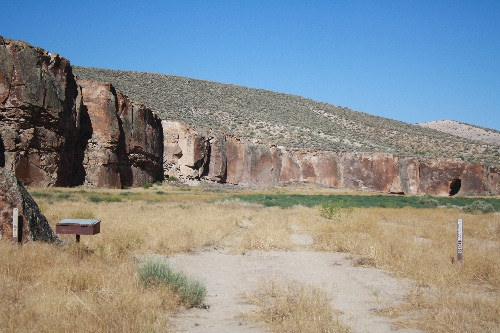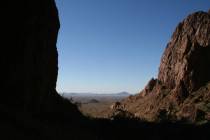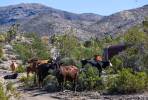Take a trip to Lincoln County to see Nevada rock art sites
Lincoln County, Clark County's neighbor to the north, is home to dozens of the finest rock art sites in Nevada. You could spend several days or longer visiting these sites, but even in a day's time, you can visit a couple of them and return home quite satisfied.
A good starter trip would be visiting the Mt. Irish Rock Art and Archeological District and the White River Narrows Archeological District, both off state Route 318, north of Alamo and Hiko, about a two- to three-hour drive from Las Vegas. To access these sites without hiking, you will need a high-clearance vehicle with good off-road tires.
Assuming you would start at the most northerly location and work your way back, you would begin at the White River Narrows area. The rhyolite cliffs are worth seeing. The most impressive petroglyph area is what is called the Amphitheater found at the terminus of the road.
After parking at the register box, signing in and picking up a fact sheet on the different sites in this district, just walk 100 yards or so to the cliff face on your left and follow it. At every bend and turn you will find petroglyphs. Most are prehistoric American Indian carvings, but there are also some pioneer glyphs carved by early settlers of European descent. There are many other rock art panels in this district, including a petroglyph that is called a "calendar fence," which is on the fact sheet and can be found on a cliff face off a spur road on your return along the access road.
Returning to state Route 318, drive about 20.1 miles south about one mile past the well-marked entrance to the Key Pittman Wildlife Management Area, look on your right for a gravel road, marked with a gate and a BLM sign. Drive in about nine miles to the Mt. Irish area. Chipped and ground stone, rock shelters and the petroglyphs studied there suggest the sites were occupied from 1000 B.C. to the 1860s. The petroglyphs are especially well-preserved, and there is quite a variety, including bighorn sheep, deer and anthropomorphs (figures that resemble human bodies). The rock art is distributed in three different parts of the area, so be sure to look at all three concentrations.
On any petroglyph excursion, it's a good idea to carry binoculars and telephoto lenses (if you have them) so you need not climb to get a close look at an inconveniently located rock drawing.
The magnifying hardware might not merely preserve your life and dignity but also the petroglyphs you enjoy. It would be irresponsible to touch, climb on or otherwise disturb petroglyphs, pictographs or the boulders and cliffs they may be on.
We know now they are much more easily damaged than previously thought, even by the oils in one's fingertips. And they are an irreplaceable part of our heritage, with stories we may yet decipher, from a time otherwise lost to human memory.
For specifics on these rock art sites and others in Lincoln County and for GPS coordinates, visit lincolncountynevada.com to download the Rock Art Guide from the Parks And Points of Interest pull-down menu and then Maps and Brochures. This is an informative website that will be helpful not only when visiting these rock art sites but also when looking for lodging or further adventures in Lincoln County.
Deborah Wall is the author of "Great Hikes, A Cerca Country Guide" and "Base Camp Las Vegas: Hiking the Southwestern States," published by Stephens Press. She can be reached at deborabus@aol.com.
Directions
From Las Vegas, take Interstate 15 north for 21 miles, exiting onto U.S. Route 93 north, the Great Basin Highway. Follow U.S. 93 north for about 85 miles, traveling through Alamo and Ash Springs and go left onto Nevada state Route 318. For the White River Narrows, drive about 23 miles north on NV-318 to the entrance road on your right. Drive about two miles (staying left at the forks) to the register and amphitheater. If you are just going to the Mt. Irish site, drive north for about four miles on NV-318 and look for the BLM sign and gate on your left, then drive about nine miles.




























